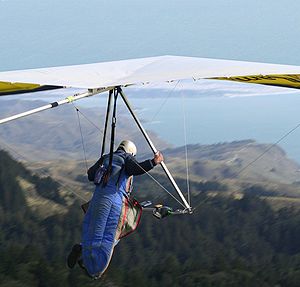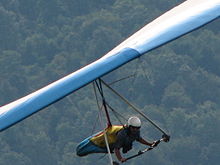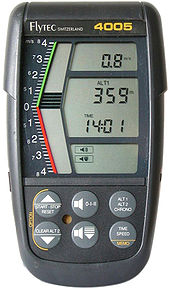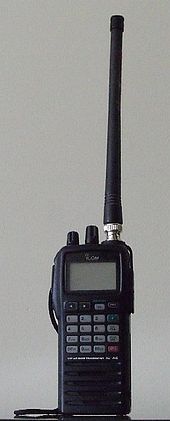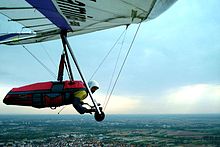- Hang gliding
-
Hang gliding Hang glider launching from Mount Tamalpais Part of a series on
Categories of aircraftSupported by lighter-than-air gases (aerostats) Unpowered Powered Supported by LTA gases + aerodynamic lift Unpowered Powered - Hybrid moored balloon
- Kytoon
Supported by aerodynamic lift (aerodynes) Unpowered Powered Unpowered fixed-wing Powered fixed-wing - Glider
- Hang gliders
- Paraglider
- Kite
- Airplane (aeroplane)
- Powered paraglider
- Flettner airplane
- Ground-effect vehicle
Powered hybrid fixed/rotary wing Unpowered rotary-wing Powered rotary-wing - Autogyro
- Gyrodyne ("Heliplane")
- Helicopter
Powered aircraft driven by flapping Other means of lift Unpowered Powered Hang gliding is an air sport in which a pilot flies a light and unmotorized foot-launchable aircraft called a hang glider (also known as Delta plane or Deltaplane). Most modern hang gliders are made of an aluminium alloy or composite-framed fabric wing. The pilot is ensconced in a harness suspended from the airframe, and exercises control by shifting body weight in opposition to a control frame, but other devices, including modern aircraft flight control systems, may be used. In the sport's early days, pilots were restricted to gliding down small hills on low-performance hang gliders. However, modern technology gives pilots the ability to soar for hours, gain thousands of metres of altitude in thermal updrafts, perform aerobatics, and glide cross-country for hundreds of kilometres. The Fédération Aéronautique Internationale and national airspace governing organizations control some aspects of hang gliding. Gaining the safety benefits from being instructed is highly recommended.[1][2]
Contents
History
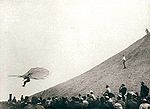 Otto Lilienthal in flight
Otto Lilienthal in flight
 Jan Lavezzari with a double sail glider
Jan Lavezzari with a double sail glider
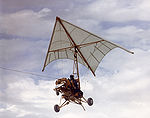 NASA's Paresev glider in flight with tow cable [1].
NASA's Paresev glider in flight with tow cable [1]. For early hang gliding, see History of hang gliding.
For early hang gliding, see History of hang gliding.Most early glider designs did not ensure safe flight; the problem was that early flight pioneers did not sufficiently understand the underlying principles that made a bird's wing work.
Starting in the 1880s technical and scientific advancements were made that led to the first truly practical gliders. Otto Lilienthal built (barely) controllable gliders in the 1890s, with which he could ridge soar. He rigorously documented his work, strongly influencing later designers; for this reason, Lilienthal is one of the best known and most influential early aviation pioneers. His aircraft was controlled by weight shift and is similar to a modern hang glider. (He was attached to the gliders by his shoulders, and swung his feet to control them.)
In the decade 1900-1910 hang gliding saw a stiffened flexible wing hang glider in 1904, when Jan Lavezzari flew a double lateen sail hang glider off Berck Beach, France. In 1910 in Breslau the triangle control frame with hang glider pilot hung behind the triangle in a hang glider was evident in a gliding club's activity.[3] The biplane hang glider was very widely publicized[4] in public magazines with plans for building; such biplane hang gliders were constructed and flown in several nations since Octave Chanute and his tailed biplane hang gliders were demonstrated. In April 1909 a how-to article by Carl S.Bates proved to be a seminal hang glider article that seemingly affected builders even of contemporary times, as several builders would have their first hang glider made from following the plan in his article.[5] Volmer Jensen with a biplane hang glider in 1940 called VJ-11 allowed safe three-axis control of a foot-launched hang glider.[6]
On November 23, 1948 Francis Rogallo and Gertrude Rogallo applied for a kite patent[7] for a fully flexible kited wing with approved claims for its stiffenings and gliding uses; the flexible wing or Rogallo wing, which in 1957 the American space agency NASA began testing in various flexible and semi-rigid configurations in order to use it as a recovery system for the Gemini space capsules. The various stiffening formats and the wing's simplicity of design and ease of construction, along with its capability of slow flight and its gentle landing characteristics, did not go unnoticed by hang glider enthusiasts. In 1960-1962 Barry Hill Palmer adapted the flexible wing concept to make foot-launched hang gliders with[8] four different control arrangements. In 1963 Mike Burns adapted the flexible wing to build a kite-hang glider he called Skiplane. In 1963, John W. Dickenson adapted the flexible wing airfoil concept to make another water-ski kite glider; for this, the Fédération Aéronautique Internationale vested Dickenson with the Hang Gliding Diploma (2006) for the invention of the modern hang glider.[9]
Training and safety
Hang gliding has traditionally been considered an unsafe sport. Modern hang gliders are very sturdy when constructed to HGMA, BHPA, DHV, or other certified standards using modern materials. Although lightweight they can be easily damaged, either through misuse or by continued operation in unsafe wind and weather conditions. All modern gliders have built-in dive recovery mechanisms such as luff lines in kingposted gliders. The inherent danger of gliding at the mercy of thermal and wind currents has nevertheless resulted in numerous fatal accidents and many serious injuries over the years, even to experienced pilots, and the resulting bad publicity has affected the popularity of hang gliding.
Pilots may carry a backup parachute in the harness. In case of serious problems the parachute is deployed and carries both pilot and glider down to earth. Pilots also wear helmets and generally carry other safety items such as knives (for cutting their parachute bridle after impact or cutting their harness lines and straps in case of a tree or water landing), light ropes (for lowering from trees to haul up tools or climbing ropes), radios (for calling for help), and first-aid equipment.
The accident rate from hang glider flying has been dramatically decreased by pilot training. Early hang glider pilots learned their sport through trial and error. Training programs have been developed for today's pilot with emphasis on flight within safe limits, as well as the discipline to cease flying when weather conditions are unfavorable, for example: excess wind or risk cloud suck.
In the UK there is one death per 116,000 flights, a risk comparable to running a marathon or playing football for a year.[10]
Launch
Video of a foot-launching from a hill
Launch techniques include foot-launching from a hill, tow-launching from a ground-based tow system, aerotowing (behind a powered aircraft), powered harnesses, and being towed up by a boat. Modern winch tows typically utilize hydraulic systems designed to regulate line tension, this reduces scenarios for lock out as strong winds result in additional length of rope spooling out rather than direct tension on the tow line. Other more exotic launch techniques have also been used successfully, such as hot air balloon drops from very high altitude. Flights in non-soarable conditions are referred to as "sled runs".
Soaring flight and cross-country flying
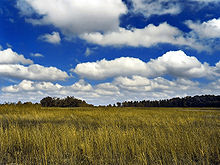 Good gliding weather. Well formed cumulus clouds with darker bases suggest active thermals and light winds.
Good gliding weather. Well formed cumulus clouds with darker bases suggest active thermals and light winds.
A glider is continuously descending through nearby air, yet glider pilots can stay airborne for hours by flying in areas of rising air. Once this skill has been mastered, pilots can glide long distances to fly cross-country (XC). Rising air masses derive from the following sources:[11]
- Thermals
- The most commonly used source of lift is created by the sun's energy heating the ground which in turn heats the air above it. This warm air rises in columns known as thermals. Soaring pilots quickly become aware of land features which can generate thermals; and of visual indications of thermals such as soaring birds, cumulus clouds, cloud streets, dust devils, and haze domes. Also, nearly every glider contains an instrument known as a variometer (a very sensitive vertical speed indicator) which shows visually (and often audibly) the presence of lift and sink. Having located a thermal, a glider pilot will circle within the area of rising air to gain height. In the case of a cloud street thermals can line up with the wind creating rows of thermals and sinking air. A pilot can use a cloud street to fly long straight-line distances by remaining in the row of rising air.
- Ridge lift
- Ridge lift occurs when the wind meets a mountain, cliff or hill. The air is deflected up the windward face of the mountain, causing lift. Gliders can climb in this rising air by flying along the feature. Another name for flying with ridge lift is slope soaring.
- Mountain waves
- The third main type of lift used by glider pilots is the lee waves that occur near mountains. The obstruction to the airflow can generate standing waves with alternating areas of lift and sink. The top of each wave peak is often marked by lenticular cloud formations.
- Convergence
- Another form of lift results from the convergence of air masses, as with a sea-breeze front. More exotic forms of lift are the polar vortexes which the Perlan Project hopes to use to soar to great altitudes.[12] A rare phenomenon known as Morning Glory has also been used by glider pilots in Australia.[13]
Performance
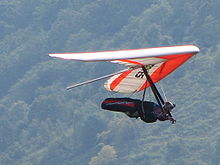 Hang gliding at Hyner, Pennsylvania.
Hang gliding at Hyner, Pennsylvania.
With each generation of materials and with the improvements in aerodynamics, the performance of hang gliders has increased. One measure of performance is the glide ratio. For example, a ratio of 12:1 means that in smooth air a glider can travel forward 12 meters while only losing 1 meter of altitude.
Some performance figures as of 2006:
- Topless gliders (no kingpost): glide ratio ~17:1, speed range ~30 to >145 km/h, best glide at ~45 to 60 km/h
- Rigid wings: glide ratio ~20:1, speed range ~ 35 to > 130 km/h, best glide at ~50 to 60 km/h.
- Ballast
- The extra weight provided by ballast is advantageous if the lift is likely to be strong. Although heavier gliders have a slight disadvantage when climbing in rising air, they achieve a higher speed at any given glide angle. This is an advantage in strong conditions when the gliders spend only little time climbing in thermals.
Stability and equilibrium
Because hang gliders are most often used for recreational flying, a premium is placed on gentle behavior especially at the stall and natural pitch stability. The wing loading must be very low in order to allow the pilot to run fast enough to get above stall speed. Unlike a traditional aircraft with an extended fuselage and empennage for maintaining stability, hang gliders rely on the natural stability of their flexible wings to return to equilibrium in yaw and pitch. Roll stability is generally set to be near neutral. In calm air, a properly designed wing will maintain balanced trimmed flight with little pilot input. The flex wing pilot is suspended beneath the wing by a strap attached to his harness. The pilot lies prone (sometimes supine) within a large, triangular, metal control frame. Controlled flight is achieved by the pilot pushing and pulling on this control frame thus shifting his weight fore or aft, and right or left in coordinated maneuvers.
- Roll
- Most flexible wings are set up with near neutral roll due to sideslip (anhedral effect). In the roll axis, the pilot shifts his body mass using the wing control bar, applying a rolling moment directly to the wing. The flexible wing is built to flex differentially across the span in response to the pilot applied roll moment. For example, if the pilot shifts his weight to the right, the right wing trailing edge flexes up more than the left, allowing the right wing to drop and slow down.
- Yaw
- The yaw axis is stabilized through the sweep back of the wings. The swept planform, when yawed out of the relative wind, creates more lift on the advancing wing and also more drag, stabilizing the wing in yaw. If one wing advances ahead of the other, it presents more area to the wind and causes more drag on that side. This causes the advancing wing to go slower and to fall back. The wing is at equilibrium when the aircraft is traveling straight and both wings present the same amount of area to the wind.
- Pitch
- The pitch control response is direct and very efficient. It is partially stabilized by the sweep of the wings. The wing center of gravity is close to the hang point and, at the trim speed, the wing will fly "hands off" and return to trim after being disturbed. The weight-shift control system only works when the wing is positively loaded (right side up). Positive pitching devices such as reflex lines or washout rods are employed to maintain a minimum safe amount of washout when the wing is unloaded or even negatively loaded (upside down). Flying faster than trim speed is accomplished by moving the pilot's weight forward in the control frame; flying slower by shifting the pilot's weight aft (pushing out).
Furthermore, the fact that the wing is designed to bend and flex, provides favorable dynamics analogous to a spring suspension. This allows the wing to be less susceptible to turbulence and provides a gentler flying experience than a similarly sized rigid-winged aircraft.
Instruments
To maximize a pilot's understanding of how the hang glider is flying, most pilots carry instruments. The most basic being a variometer and altimeter—often combined. Some more advanced pilots also carry airspeed indicators and radios. When flying in competition or cross country, pilots often also carry maps and/or GPS units. Hang gliders do not have instrument panels as such, so all the instruments are mounted to the control frame of the glider or occasionally based on one's watch.
Variometer
Main article: VariometerGliding pilots are able to sense the acceleration forces when they first hit a thermal, but have difficulty gauging constant motion. Thus it is difficult to detect the difference between constantly rising air and constantly sinking air. A variometer is a very sensitive vertical speed indicator. The variometer indicates climb rate or sink rate with audio signals (beeps) and/or a visual display. These units are generally electronic, vary in sophistication, and often include an altimeter and an airspeed indicator. More advanced units often incorporate a barograph for recording flight data and/or a built-in GPS. The main purpose of a variometer is in helping a pilot find and stay in the ‘core’ of a thermal to maximize height gain, and conversely indicating when he or she is in sinking air and needs to find rising air. Variometers are sometimes capable of electronic calculations to indicate the optimal speed to fly for given conditions. The MacCready theory answers the question on how fast a pilot should cruise between thermals, given the average lift the pilot expects in the next thermal climb and the amount of lift or sink he encounters in cruise mode.[14] Some electronic variometers make the calculations automatically, allowing for factors such as the glider's theoretical performance (glide ratio), altitude, hook in weight, and wind direction.
Radio
Pilots use radio for training purposes, and for communicating with other pilots in the air – particularly when traveling together on cross-country flights.
One type of radios used are PTT (push-to-talk) transceivers, operating in or around the FM VHF 2-meter band (144 MHz–148 MHz). Usually a microphone is incorporated in the helmet, and the PTT switch is either fixed to the outside of the helmet, or strapped to a finger. Operating a 2-meter band radio without an appropriate Amateur Radio license is illegal in most countries that have regulated airwaves (such as the United States).
As aircraft operating in airspace occupied by other aircraft, hang glider pilots also use the appropriate type of radio i.e. the aircraft transceiver. It can, of course, be fitted with a PTT switch to a finger and speakers inside the helmet. The use of aircraft transceivers is subject to regulations specific to the use in the air such as frequencies restrictions but has several advantages over FM (i.e. frequency modulated) Amateur Radios. One is the great range it has (without repeaters) because of its amplitude modulation (i.e. AM). Two is the ability to contact, inform and be informed directly by other aircraft pilots of their intentions thereby improving collision avoidance and increasing safety. Three is to allow greater liberty regarding distance flights in regulated airspaces, in which the aircraft radio is normally a legal requirement. Four is the universal emergency frequency monitored by all other users and satellites and used in case of emergency or impending emergency.
GPS
GPS (global positioning system) is a necessary accessory when flying competitions, where it has to be demonstrated that way-points have been correctly passed.
It can also be interesting to view a GPS track of a flight when back on the ground, to analyze flying technique. Computer software is available which allows various analyses of GPS tracks.
Other uses include being able to determine drift due to the prevailing wind when flying at altitude, providing position information to allow restricted airspace to be avoided, and identifying one’s location for retrieval teams after landing-out in unfamiliar territory.[citation needed]
More recently, the use of GPS data, linked to a computer, has enabled pilots to share 3D tracks of their flights on Google Earth. This fascinating insight allows comparisons between competing pilots to be made in a detailed post-flight analysis.[citation needed]
Records
Records are sanctioned by the FAI. The world record(s) (as of 2005) for "free distance" is held by Manfred Ruhmer with 700.6 km (435.3 mi) in 2001 and Michael Barber flew a distance of 704 km (437 mi) on June 19, 2002 in Zapata Texas.[15]
Other records include:
Out-and-Return distance - 332.5 km (206.6 mi), July 5, 2007 by George Stebbins, starting and ending just South of Lone Pine, California.
Largest triangle - 357.12 km (221.90 mi), December 16, 2000 by Tomáš Suchánek a Czech HG and sailplane pilot, starting and ending from Riverside, Australia.[citation needed]Competition
Competitions started with "flying as long as possible" and spot landings. With increasing performance, cross-country flying replaced them. Usually two to four waypoints have to be passed with a landing at a goal. In the late 1990s low-power GPS units were introduced and have completely replaced photographs of the goal. Every two years there is a world championship. The Rigid and Women's World Championship in 2006 was hosted by Quest Air in Florida. Big Spring, Texas hosted the 2007 World Championship. Hang gliding is also one of the competition categories in World Air Games organized by Fédération Aéronautique Internationale (World Air Sports Federation - FAI), which maintains a chronology of the FAI World Hang Gliding Championships.[16]
Aerobatics
Hang gliders are not certified for aerobatic flight. Pilots perform aerobatics at their own risk. There are three basic maneuvers in a hang glider, not counting a loop, which is actually a climbover with the same entry and exit heading. The following descriptions are excerpts from a nationally recognized rules book.
3.1 Official Maneuvers A figure with a bank angle of more than 90° is a maneuver.
3.1.1 Loop A loop is defined as a maneuver that starts in a wings level dive, climbs, without any rolling, to the apex where the glider is upside down, wings level (heading back where it came from), and then returning to the start attitude and heading, again without rolling, having completed an approximately circular path in the vertical plane.
3.1.2 Spin A spin is scored from the moment one wing stalls and the glider rotates noticeably into the spin. The entry heading is noted at this point. The glider must remain in the spin for at least 1/2 of a revolution to score any versatility spin points.
3.1.3 Rollover A Rollover is a maneuver where the apex heading is less than 90° left or right of the entry heading.
3.1.4 Climb over A Climb over is a maneuver where the apex heading is greater than 90° left or right of the entry heading.
Classes
For competitive purposes, there are three classes of hang glider:
- Class 1 The flexible wing hang glider, having flight controlled by a wing whose shape changes by virtue of the shifted weight of the pilot. This is not a paraglider.
- Class 5 The rigid wing hang glider, having flight controlled by spoilers, typically on top of the wing. In both flexible and rigid wings the pilot hangs below the wing without any additional fairing.
- Class 2 (designated by the FAI as Sub-Class O-2) where the pilot is integrated into the wing by means of a fairing. These offer the best performance and are the most expensive.
In addition to typical launch configurations, a hang glider may be so constructed for alternative launching modes other than being foot launched; one practical avenue for this is for people who physically cannot foot-launch.[17]
Comparison of gliders, hang gliders and paragliders
There can be confusion between gliders, hang gliders, and paragliders. Paragliders and hang gliders are both foot-launched glider aircraft and in both cases the pilot is suspended ("hangs") below the lift surface, but "hang glider" is the default term for those where the airframe contains rigid structures. The primary structure of paragliders is supple, consisting mainly of woven material.[18]
The main differences between the types are:[citation needed]
Paragliders Hang gliders Gliders/Sailplanes Undercarriage Pilot's legs used for take-off and landing Pilot's legs used for take-off and landing Aircraft takes off and lands using a wheeled undercarriage or skids Wing structure entirely flexible, with shape maintained purely by the pressure of air flowing into and over the wing in flight and the tension of the lines generally flexible but supported on a rigid frame which determines its shape, but note that rigid wing hang gliders also exist rigid surface to wings that totally encases structure Pilot position sitting supine in a seated harness. usually lying prone in a cocoon-like harness suspended from the wing. Seated, and 'supine' are also possible. sitting in a seat with a harness surrounded by a crash-resistant structure. Speed range
(stall speed – max speed)slower – typically 25 to 60km/h for recreational gliders (over 40km/h requires use of speed bar)[19] hence easier to launch and fly in light winds, least wind penetration, pitch variation can be achieved with the controls. easier to launch and fly in stronger conditions with better wind penetration, and can outrun bad weather, weight shift pitch control[citation needed] even faster - maximum speed up to about 280 km/h (170 mph); stall speed typically 65 km/h (40mph). Able to fly in windier turbulent conditions and can outrun bad weather. Exceptional penetration into the wind. Semi- or fully aerobatic. Maximum glide ratio about 10, relatively poor glide performance makes long-distances more difficult. The current world record is just above 500 km (310 miles)[20] about 17 for flexible wings, though up to 20 for rigid wings.[citation needed] Open class sailplanes typically around 60:1 but in more common 15-18 meter span aircraft, glide ratios are between 38:1 and 52:1. [21], high glide performance enabling long distances, 3,000 km (1,800+ mile record)[22] Turn radius tighter turn radius, allowing circling in the rapidly rising center of thermals somewhat larger turn radius, not allowing such a high rate of climb in thermals even greater turn radius but still able to circle tightly in thermals Landing smaller space needed to land, offering more landing options from cross-country flights. Also easier to carry back to the nearest road longer approach & landing area required, but can reach more landing areas due superior glide range can land in less than 200 metres and can often reach another airfield.[citation needed] Specialised trailer needed to retrieve by road Learning simplest and quickest to learn teaching is done in a two seat glider with dual controls Convenience packs smaller (easier to transport and store); lighter (can be easily carried considerable distances); quicker to rig & de-rig; transported in the trunk of a car more awkward to transport & store; longer to rig and de-rig; transported on the roof of a car trailers are typically 10 m (30 ft) long. Rigging & de-rigging takes about 20 minutes Cost cost new €2000 up[23], cheapest but shortest lasting (around 500 hours flying depending on treatment) but active second hand market[24] cost of new gliders very high but long lasting (several decades), so active second hand market typically from €2000 to €145,000[25] . Often shared ownership[citation needed] See also
- Gliding
- Paragliding
- Microlift gliding
- Nanolight
- Powered paragliding
- Powered hang gliding
- Comparison with gliders and paragliders
- Kite types - paragliders and the types of hang gliders having the pilot hang from a kite line are types of kites where the kite lines vary in length and number and the gravity-drawn mass of the pilot is the moving mooring.
- USHPA - US Hang Gliding & Paragliding Association
References
- Notes
- ^ How to Buy a Hang Glider by George Meadows.
- ^ Learning to Hang Glide
- ^ http://lh4.ggpht.com/_y21JroWG1xg/SG6MAf0c7KI/AAAAAAAAATk/CoCQ25QpLrM/1908StephanNitschCollection.jpg 1908 hang glider in Breslau territory with pilot hung behind cable-stayed triangle control frame, a device used through 1900s up to today.
- ^ The Octave Chanute Pages
- ^ The Popular Mechanics Glider
- ^ VJ-11 Information Page. The history of the VJ-11 hang glider.
- ^ Flexible kite
- ^ Carl S. Bates
- ^ FAI Award: The FAI Hang Gliding Diploma
- ^ Risk of dying and sporting activities, http://www.medicine.ox.ac.uk/bandolier/booth/Risk/sports.html, retrieved 2011-05-31
- ^ Pagen, Dennis (January 1992). Understanding the Sky - A Sport Pilot's Guide to Flying Conditions. Mingoville, Pennsylvania, USA: Dennis Pagen. pp. 280. ISBN 13: 978-0936310107.
- ^ Perlan Project
- ^ A Guide to the Morning Glory
- ^ http://www.modelaircraft.org/museum/bio/MacCready.pdf
- ^ Mike Barber needed to fly 1% further than Ruhmer's 700 km (430 mi) in order to break the official FAI record; Barber needed to fly only 3 more miles for a total of 708 kilometres (440 mi). Barber's flight remains the longest hang glider flight ever.
- ^ Chronology of the FAI World Hang Gliding Championships
- ^ Dan Buchanan
- ^ Paragliding: the Complete Guide, Noel Whittall, The Lyons Press (www.lyonspress.com)
- ^ Technical data for Advance Omega 8 - accessed 22-10-2011
- ^ FAI Paragliding record - accessed 2010-11-30
- ^ Handicap list 2008 of the Deutscher Aero Club - accessed 2008-08-07
- ^ FAI records Accessed 30 November 2010
- ^ major manufactures price list - accessed 2011-10-21
- ^ Typical set of classified ads
- ^ Typical set of classified ads
- Bibliography
- "Hang-gliding -- the new sport" (pdf). Flight International. 9 May 1974. http://www.flightglobal.com/pdfarchive/view/1974/1974%20-%200709.html.
- Ann Welch (10 December 1977), "Hang-gliding review" (pdf), Flight International, http://www.flightglobal.com/pdfarchive/view/1977/1977%20-%203738.html
- Ann Welch (14 June 1973), "LIKE A BIRD ON THE BREEZE" (pdf), Flight International: 921-923, http://www.flightglobal.com/pdfarchive/view/1973/1973%20-%201667.html
External links
- How hang gliding works: Rogallo wing
- Hang glider "bible"
- Hang gliding records
- Hang gliding at the Open Directory Project
- Hang gliding photos
- Hang gliding photos
- Otto Lilienthal video photo montage
- Hang gliding pioneers video interview
- The US Hang Gliding and Paragliding Association History
Extreme and adventure sports Boardsports Motorsports Water sports Rafting · Whitewater kayaking · Whitewater canoeing · Free-diving · Scuba diving · Coasteering · Jet Ski · WaterskiingMountaineering Free fall Flying Others Mountain biking · BMX · Inline skating · Parkour · Cliff diving · Paintball · Orienteering · Rappelling · Caving · Zip-lining · Freestyle skiing · Powerbocking · Stunt pogoing · Slacklining · Freestyle scooteringCategories:- Adventure travel
- Hang gliding
- Aeronautics
- Aircraft configurations
- Air sports
- Individual sports
Wikimedia Foundation. 2010.

